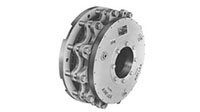Model DBA brakes are spring applied, pressure released, disc style brakes. They develop equal torque in either direction of rotation. Their torque and thermal capacities allow them to be used in the most demanding applications.
Brake construction and operation is shown in the figure. Pressurizing the brake compresses the brake springs and withdraws the clamping plates from the brake discs. Standard brakes are furnished with either one or two discs, which are free to move axially.
Model DBA uses a rubber diaphragm to form the releasing pressure chamber and to serve as the releasing piston. Brake friction material is attached to stationary components. Brake discs are either solid or ventilated. The disc type is indicated by an S for solid, or V, for ventilated, in the brake model designation. Solid discs are used in applications requiring a heat sink and/or where engagement is infrequent. Ventilated discs are recommended for cyclic applications.
Torque ratings listed are for brakes with a standard compliment of springs. The quantity of springs can be varied to customize the torque of the brake to suit a particular application. Consult the factory for brake torque of units with nonstandard spring configurations.
Brake sizes are indicated by the number of brake discs and the disc diameter in inches. For instance, size 229DBA has two discs 29 inches in diameter.


